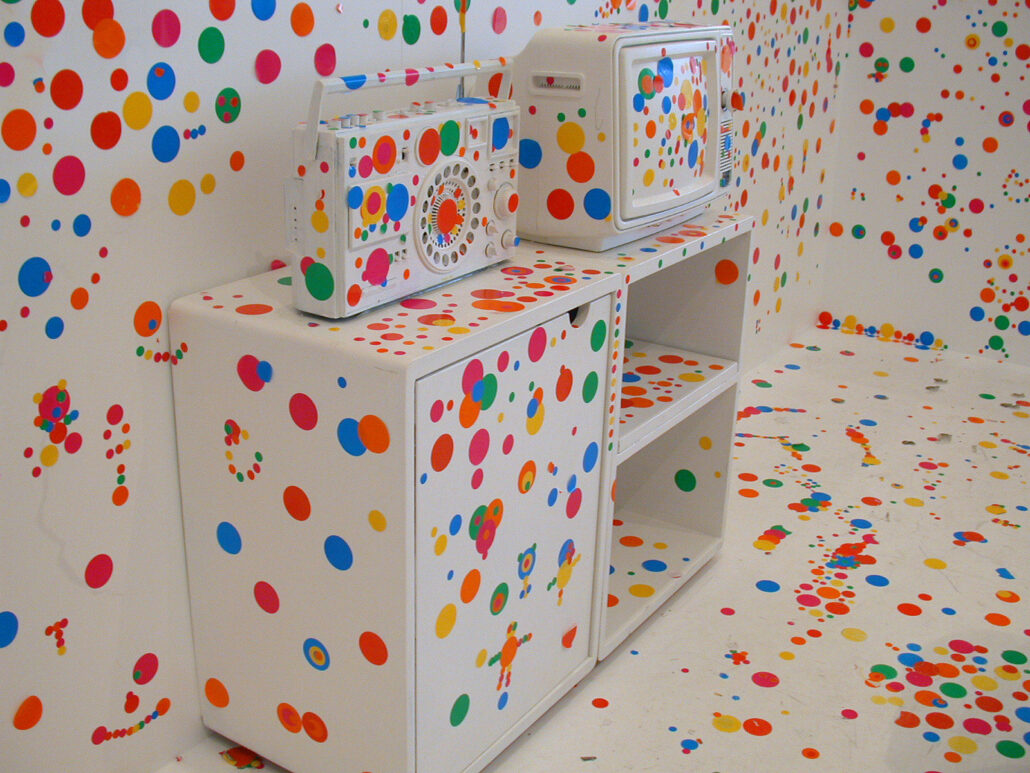Part 1: The Original Obliteration Room and Children's Play
Time Versus the Timeless Museum Space
As Brian O’Doherty argues in his book, Inside the White Cube, the white gallery space historically existed as a way to frame artworks as both modern and timeless. The fully white gallery space isolated an artwork from all other context and historical cues, thereby eradicating the notion of time and instead imbuing an art piece with a sense of timelessness and permanence.[1] Kusama’s Obliteration Room, however, is explicitly not a timeless space. The work critiques the white gallery space by adding a sense of time back into a formerly uncontextualized space. By bringing the audience into the present, Kusama is grounding them in a familiar space as well as allowing the work to have more realistic stakes for the audience. They are not “obliterating” a random space, they are “obliterating” a space in which they have a personal connection. Her rooms communicate a very concrete time as they are created with furniture bought by the museum and intended to reflect the years in which they are installed in the museum. Her 2002 Obliteration Room at the QAGOMA features a CRT TV and large radio, (Fig. 3), while her 2015 room at the Zwirner Gallery includes a compact touchpad computer (Fig. 16), and her 2018 room at the AGO includes a flat-screen computer monitor and attached keyboard. These are technologies that would not have been created during her initial conception of the art piece and then implies that the rooms reflect their contemporary years instead of conveying a sense of permanence or timelessness.

O’Doherty also argues that the pristine white of the gallery space is intruded upon by both the furniture that the gallery provides for viewers to sit and by the bodies of the viewers themselves. He goes further to suggest that, in three-dimensional real spaces that are replicated and displayed as art in a gallery, the spectators then act as trespassers within the space. The “trespassing” visitor, unable to interact with the space, is then acutely aware of the space that their body takes up within the gallery and therefore plays down their body language and remains silent. Kusama’s rooms, while appropriating the living room for artistic purposes, are also explicitly not direct quotations. The white paint on all the surfaces transforms a familiar domestic room into an unfamiliar, alienating space, thereby forcing the participants to consider their own interactions with the room and its furnishings. Audiences are met with a traditionally private, invitation-only space and are welcomed inside by Kusama and the hosting museums. As an outsider, they are then explicitly asked to interact with and alter the formerly private space with Kusama acting as owner of the space but also as hospitable host. By offering up a formerly private space, Kusama is not only bringing her audience together in a shared sacred space, she is doing so in a present and current space that they would be familiar with, making the experience more personal and relatable.
Additionally, before the stickers, the white gallery walls bleed into every surface in The Obliteration Room.Rather than act as framing devices, Kusama removed any division between the white gallery walls and her art.[2] The walls act as participants within the work, rather than as borders. Visitors are also participants now, as they are encouraged by Kusama to touch the space and to actively “obliterate” it, slowly covering all white areas. As the stickers are added, the space of the gallery as delineated by the white color, slowly disappears, being “obliterated” by the brightly colored dots, and is replaced with circular rainbow stickers.

